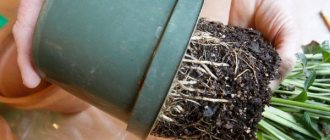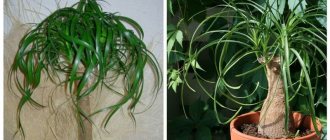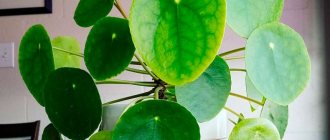Calathea crocata. Photo Calathea belongs to the Marantaceae family. The homeland of calathea is South America, where it grows in tropical rainforests. The plant is hidden from the scorching sun by the spreading branches of tall trees.
Calathea got its name from the word “calathos”, which translates from the Greek “basket” - its leaves were used in ancient times for weaving.
It is a herbaceous perennial plant with many varieties, tuberous and rhizomatous. The leaves grow on elongated petioles and are usually pink or purple on the underside. Blooms from early spring to mid-summer, depending on the species. If the conditions are suitable for her, the flowering period lasts up to 2-3 weeks. The inflorescences are inconspicuous: small flowers are compactly collected in spike-shaped inflorescences. Their color is varied.
| The growth rate is low, up to 7 new leaves per year. |
| Blooms from early spring to mid-summer, depending on the species. |
| The plant is grown with difficulty. |
| It is a perennial plant. |
Caring for calathea at home. Briefly
Calathea at home requires special attention; if care requirements are not followed, problems will arise and the plant may die:
| Temperature | 16-24°C in summer, about 16°C in winter, at least up to 10°C. Avoid temperature changes. |
| Air humidity | From 60%. Maintained by regular spraying - at least 3 times a week. Do not wet varieties with terry leaves, but humidify the air next to them. |
| Lighting | Moderate, keep away from direct sunlight. The optimal location is 2 meters from the window in a western direction. |
| Watering | In summer - 2-3 times a week, in winter once is enough. Do not allow water to stagnate in the pot. The water is soft and warm. |
| Priming | With the addition of sand or peat, breathable. When preparing it yourself, mix: leaf soil - 2 parts, peat - 1, sand - 1. |
| Feeding and fertilizer | During the growing season, a liquid preparation diluted 1:2 is required every 10-15 days. An excess of calcium and nitrogen is unacceptable. |
| Transfer | For young plants - every year in February or March. Next - after 2-4 years, when the pot becomes too small for the root system. |
| Reproduction | By dividing the bush when replanting, so that each plant has several leaves and 2-3 full roots. When propagated by seeds, they need to be germinated at 20-24°C. |
| Features of cultivation | In summer, the plant can be taken out into the open air - into the garden, onto the balcony, but protected from drafts. Loves the humidity of the bathroom. The leaves are folded at night. They are easy to damage, wipe with care. |
Kalateya Varshevich.
Photo For successful cultivation, you should study the care rules in more detail.
Diseases
It is important to remember that Calathea Makoya is a very capricious plant.
Therefore, all diseases appear only from improper care. Leaves can dry out and turn yellow due to excess moisture, unwanted spraying with water, or lack of light . Also from moisture getting on the leaves and stem of the plant.
Calathea Makoya is a very capricious perennial. Requires special care. The plant needs systematic watering with boiled water, constant lighting even in winter, and additional feeding.
The flower cannot be poured or sprayed from a spray bottle. Do not apply chemicals against pests. The plant prefers peace, bright, warm rooms without winds and drafts.
Caring for calathea at home. Details
Indoor calathea is not the most capricious plant, but it is not unpretentious either.
If the temperature, humidity, or light levels deviate from its normal level, the calathea may get sick and die. Some varieties are hardier and cope better with indoor conditions than others, such as Makoya. The main problem with growing in apartments is dry air during the cold season due to radiators and heaters. Its leaves have a large area from which evaporation constantly occurs. In tropical forests, losses are compensated by moist air, but in a dry room the process is too intense. The root system does not have time to replenish reserves, which is why the leaves begin to dry out.
Such features require a more attentive attitude to the plant and compliance with care requirements.
Calathea flowering
Calatheas produce small flowers of various shades - they depend on the type of plant.
Makoya, wonderful and mosaic calathea have white, tubular-shaped inflorescences released from the base of the leaves. Saffron calathea is notable for its bright orange flowers, and zebrina has lilac flowers. To increase the flowering period, flower growers use one trick. Usually such measures bring good results in the case of saffron calathea. It blooms for 2-3 months. When its shoots have grown by more than 15 cm, in mid-August the pot is moved to a darker place for 10 weeks.
Watering is reduced to a minimum. At this time, the flower will create new buds. Upon returning to the previous bright place, resume regular watering. After another 2 months, the calathea will bloom.
Temperature
Calathea at home loves warmth and does not tolerate drafts and temperature changes. In summer, the normal temperature for it is considered to be 22…24°C. In winter, it is optimal to maintain 16…18°C.
If the temperature is above 20 degrees, then it is necessary to provide the flower with additional air humidification.
Spraying
Spraying is useful for calathea, and even a warm shower will benefit the plant. But this only applies to varieties with smooth leaves. Terry representatives should be protected from contact with water drops on the surface. In this case, the best option is to humidify the air around the plant.
Lighting
The calathea flower at home does not tolerate the sun; direct exposure to the rays can be destructive for it.
The leaves react painfully - they curl up, their color changes and becomes paler. Burns will be visible on the surface. When choosing a place for a pot, preference should be given to a western or eastern window, but not on the windowsill, but a couple of meters from it.
The room should be light enough. If you place the plant in a dark corner, it will need additional lighting from artificial sources for at least 12-14 hours a day.
The fluorescent lamp should be installed at a distance of 20 cm from the leaves.
Watering
You should be extremely careful about watering. Homemade calathea does not tolerate either overdrying or excessive moisture or stagnation of water in a pot or tray.
Fleshy leaves absorb water in large quantities, so a lack of moisture poses a threat to the health of the plant. If there is an excess, there is a growth arrest and a depressed state. The leaves become covered with spots, which indicates the beginning of rotting of the root system.
To avoid problems with watering, you should choose a light soil substrate for the flower. It should resemble the soil of the calathea's natural habitat. They grow on loose, light soils that do not retain water. For a plant, stagnation of moisture is much more dangerous than its lack. They are prepared for drought - the root system has tuberous processes that satisfy the need for water if necessary.
There is no need to water the plant until the soil in the pot dries out after previous moistening.
Calathea pot
The pot should be chosen to be small, since calathea has a superficial root system. Because of this, the excess volume of soil risks turning sour. A low and wide option would be ideal. It is better if it is clay - in such a container there is less risk of water stagnation.
If the roots of an adult plant appear through the drainage hole, then the pot is small and the plant needs to be replanted.
Soil for calathea
The soil should be light, loose, water- and breathable. The easiest way to prepare your own substrate is this recipe: leaf soil, peat and sand in a ratio of 2:2:1. Additives such as sphagnum, crushed pine bark, coco soil, and pieces of charcoal enrich the mineral composition of the soil. Store-bought soil may not be suitable for calathea; coarse sand must be added to it to loosen it.
Feeding and fertilizer
For calathea, home care should be accompanied by periodic improvement of soil quality. Organic fertilizers are beneficial, but an excess of salts can be detrimental to the flower. Fertilizing is carried out with liquid products in half the dose recommended by the manufacturer.
The frequency of procedures is once every 2 weeks.
Calathea transplant
Frequent transplants are harmful to the plant and can be difficult to tolerate. The young flower must be transferred annually to a new pot, more suitable in size for the grown root system.
When replanting, you should not remove the soil from the roots to avoid damaging them, but place them in a new container with a lump of earth. Be sure to equip the pot with a drainage layer to remove moisture. An adult plant is replanted every 2-4 years , depending on the intensity of growth.
Trimming
Calathea leaves are cut off if they are completely dry. When transplanting a plant and propagating by division, all dry and diseased parts of the plant are removed from the bushes.
Is it possible to leave Calathea without care during the holidays?
Long-term lack of care can cause irreparable damage to the health of the plant, resulting in its death. Calathea cannot be watered “in reserve” - excessive moisture will lead to rotting of the roots. Lack of moisture is also harmful to the flower. If the absence of hosts lasts 3-5 days, the plant will cope. But a longer stay without care is unacceptable.
Transfer
Due to the specific toxins released into the soil by the roots of the plant and leading to its death, replanting is a necessary procedure for calathea. It is better to carry it out in early spring.
Reasons for transplant:
- disease;
- growth of the root system;
- 14 days have passed since the purchase.
Before the calathea reaches 3 years, it needs to be replanted annually, then every 2-3 years.
Transplant instructions:
- water the plant generously 1.5 hours before transplanting;
- Place a drainage layer a quarter of the height of the container on the bottom of the flowerpot, sprinkle it with crushed charcoal or activated carbon to prevent root rotting;
- pour a layer of soil on top not exceeding 2–3 cm;
- carefully remove the calathea from the old container along with a lump of earth;
- rinse the roots in cool water;
- cut all damaged roots with a sharp knife strictly perpendicularly, remove old and dry leaves;
- treat the cut areas with crushed activated carbon or wood ash;
- place the plant in a new pot and soil, carefully straighten the roots;
- make sure that the growing point is strictly in the center of the flowerpot and above the soil surface;
- carefully pour the soil into the pot, leaving 1.5–2 cm to its upper edge;
- lightly press, but do not compact the soil.
After replanting, it is necessary to water the calathea generously and put it away for 2-3 days in a cool place where direct sunlight does not penetrate. The next watering is carried out after 8–10 days.
Calathea propagation
The plant can be propagated in three ways: division, cuttings and seeds.
Reproduction of calathea by dividing the bush
Most often, calathea is propagated by dividing the bush - this is the most effective way, which allows the seedling to quickly adapt and begin to grow. Only healthy and large plants are suitable for division.
The bush is disassembled by hand so that each part has 2-3 leaves and several high-quality roots. Divisions that are too small take root very poorly and may die.
The seedling is immersed in light soil of peat and sand, the upper part is covered with a plastic bag, maintaining high humidity underneath. When growth and the appearance of new leaves are noticeable, the plant is transferred to normal conditions.
Propagation of calathea by cuttings
Propagation by cuttings is available for calathea. In this case, a stem with a length of 15 cm is selected. It should have a growing point and 3-4 leaves. The stem is planted in a substrate of peat and sand.
The pot is left in a warm and very humid place until the cuttings take root.
Growing calathea from seeds
Not the most popular way to propagate calathea is through seeds. They are laid on the soil surface for several weeks, slightly pressed down on top, and covered with glass on top to create a greenhouse effect. After germination, they should be sprinkled with 1 cm of soil.
When sprouts appear, you need to start airing: remove the glass for 30 minutes. If the plants have reached 2-3 cm in length, then it’s time to replant them in separate pots and care for them as usual.
What kind of soil is needed?
The soil for calathea should be moisture-permeable, nutritious, have good aeration and weak (pH 5.0–6.0) or neutral (pH 6.0–7.0) acidity.
You can use ready-made soil for arrowroot or azaleas, or prepare it yourself by mixing in equal parts:
- high peat;
- leaf soil;
- humus;
- coarse sand.
To deoxidize the resulting substrate, you need to add crushed charcoal to it at the rate of 40 grams per 1 kg of soil mixture.
The soil should not contain lime.
To get rid of pests, the soil mixture must be steamed in a water bath, poured with a weak solution of manganese, calcined in the oven, or treated with insecticides and fungicides, such as Aktara, Aktellik or Fundazol.
Diseases and pests
Calathea leaves turn yellow.
Photo Calathea can get sick, and to save the plant, you need to know the signs and causes of their occurrence:
- the tips of the leaves turn brown - the air is too dry;
- the calathea leaves have drooped and wrinkled - the air is too dry;
- Calathea leaves dry out - dry air during the heating season;
- calathea leaves curl - excessive lighting;
- white-yellow spots appear on the leaves - excessive lighting;
- leaves become covered with dark spots - excessive soil moisture;
- leaf petioles are strongly elongated - insufficient lighting;
- brown spots on calathea – sunburn;
- brown dry edges of leaves - irregular watering, hard water, dry air;
- Calathea leaves have become lethargic - cold air or temperature changes.
The cause of the deterioration of the calathea can be pests. It is susceptible to attack by spider mites - its most dangerous enemy, as well as mealybugs, scale insects and whiteflies.
Photo gallery
On the reverse side, the pattern is repeated, but the background color changes, becoming cherry. In the evening, the leaves stretch out and fold in the shape of the palms of a praying person. Therefore, people sometimes call the plant a prayer plant.
Types of homemade calathea with photos and names
Here are the most popular representatives of Calathea. They adapt to life in a city apartment more easily than others.
Calathea saffron, crocata
It has dark green leaves, violet-purple on the underside. Bright orange flowers are produced on long petioles.
Calathea painted
The oval leaves are up to 20 cm in length, in the center they have a symmetrical color of light and dark green stripes, framed along the edges with a white or pink pattern.
Makoya
A lush bush with painted leaves - the light green surface is decorated with dark ovals and thin lines. The lower part is burgundy. Blooms with purple inflorescences.
Calathea striped
Straight vertical stems grow up to 40-60 cm. Large oblong leaves also reach 40 cm. Their color is dark green, with light stripes over the entire surface.
Calathea leopardis
Elongated leaves with a pointed tip. Light green with dark stripes. Plant up to 50 cm high.
Description of the plant
Calathea Makoya is a herbaceous perennial. Belongs to the Marantaceae family. Grows in the tropics of Brazil. Latin name: Calathea makoyana. It reaches 25-45 cm in width and height. It has a shortened stem.
A large rosette with elongated leaves extends from it. The leaf blade is ovoid in shape . It reaches 18-22 cm in length and 8-12 cm in width. The leaves are graceful, thin, almost translucent.
The plant is loved by gardeners for its unusual characteristic color. The upper surface of the leaves is emerald green . Snow-white strokes extend from the center of the leaf plate, forming the background. It has elongated, egg-shaped spots.
If you look at the leaves from above, the pattern is very similar to an emerald tree against a background of snow-white spikelets and green grass. The reverse side of the sheet plate is identical to the top side. But instead of an emerald pattern, there is a crimson background. The flowers are miniature, lilac in color . Collected in dense inflorescences.
Check out other types of Calathea: Saffron, Rufibarba, Medallion, Lansifolia, Zebrina, Varshevich.
Difficulties in growing
Growing calathea at home is not easy; mistakes often occur, but you can cope with them:
| Problem | Cause | Correction |
| Dry, wilted tips of leaves. | There is not enough humidity. | Spray the plant every day. Place the pot in a container with wet filler. Place a humidifier or aquarium nearby. |
| The leaves turn brown at the ends. | - Overfeeding the plant. - Drafts. | — Reduce the supply of fertilizers, especially nitrogen. — Move the plant to a place where there are no drafts. |
| Curling of leaves, appearance of light spots. | Lack of moisture in the soil. | Increase watering. |
| Rotting of petioles and bases of leaves. | Low temperature and high humidity. | Change the conditions of detention. |
| Deciduous fault. | — Lack of air humidity. — Waterlogging of the soil. — Strongly acidic soil. | — Humidify the air around the flower. - Change the substrate. |
| Drying of leaves. | - Possibly an annual cycle of leaf replacement. — When growth slows down, there is not enough fertilizer and watering. | — Watch the plant, feed it if necessary. — Follow the watering schedule. |
| The appearance of light spots. | Burns from sunlight or after contact with drops that acted like lenses. | Move the flower to a more shaded place. Be careful when spraying; it is better to carry out the procedure in the morning or evening. |
| Pulling leaves. | Lack of light. | Light the flower with a fluorescent lamp. |
| There are slight enlargements on the back side. | Spider mites or simply frozen cell sap. | Examine the plant. If there are no webs, there is no need to worry. |











